Case Study: Cultural Identity and Psychosocial Health in Healthcare
VerifiedAdded on 2021/05/30
|7
|1541
|22
Case Study
AI Summary
This case study examines the psychosocial perspectives of healthcare, focusing on a case involving Kevin Johnson, an aboriginal adolescent with diabetes. It explores how cultural identity, socioeconomic status, and health beliefs, as social determinants of health, impact diabetes management and overall well-being. The analysis highlights the importance of understanding cultural competency in healthcare, particularly concerning the aboriginal population's reliance on traditional medicines and their perceptions of westernized treatments. The study also discusses the influence of cultural values, such as balance and respect, on health perceptions and the challenges faced by indigenous people in accessing and affording specialized care. The assignment references various studies to support its arguments, emphasizing the need for culturally sensitive approaches to improve health outcomes for aboriginal communities.
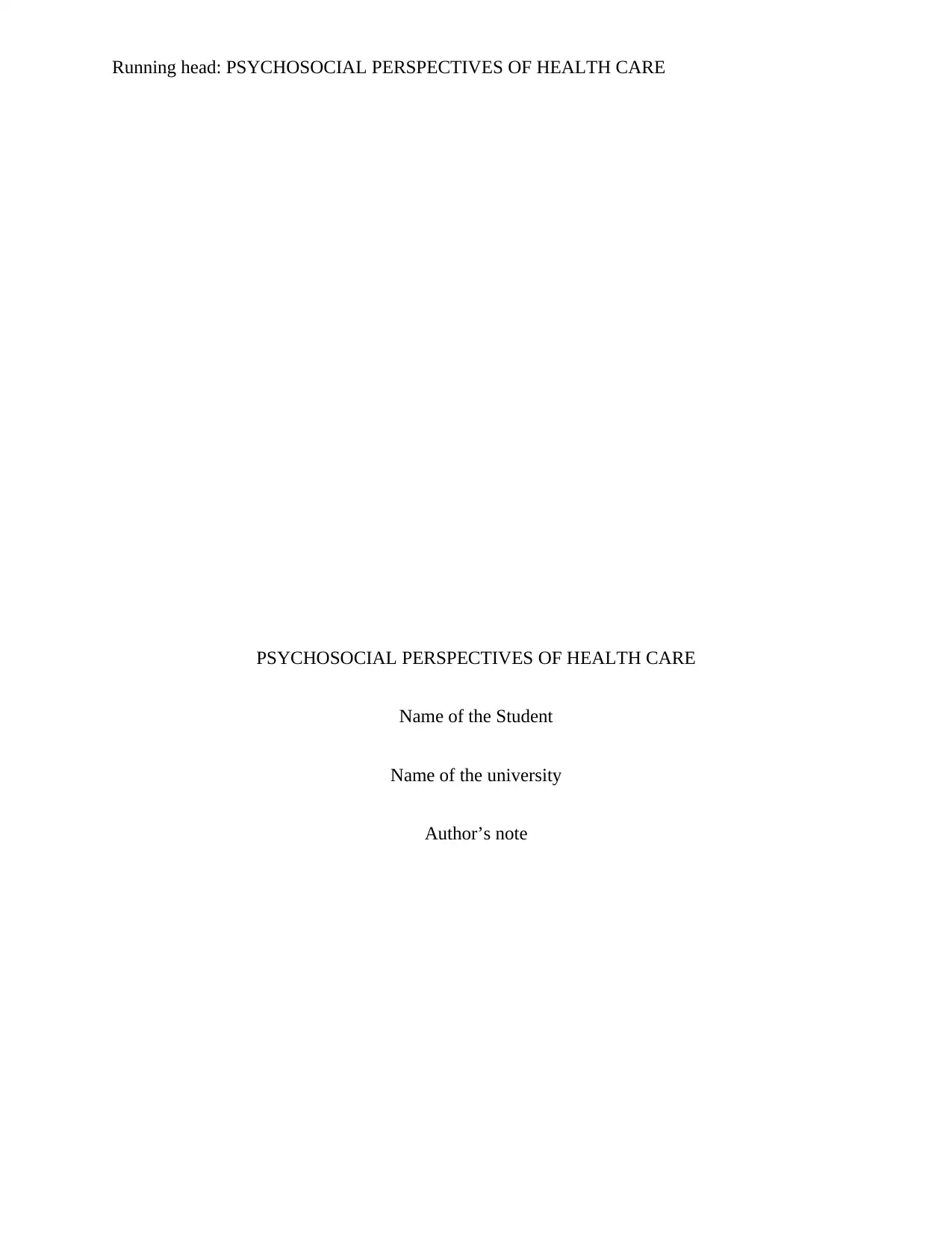
Running head: PSYCHOSOCIAL PERSPECTIVES OF HEALTH CARE
PSYCHOSOCIAL PERSPECTIVES OF HEALTH CARE
Name of the Student
Name of the university
Author’s note
PSYCHOSOCIAL PERSPECTIVES OF HEALTH CARE
Name of the Student
Name of the university
Author’s note
Paraphrase This Document
Need a fresh take? Get an instant paraphrase of this document with our AI Paraphraser
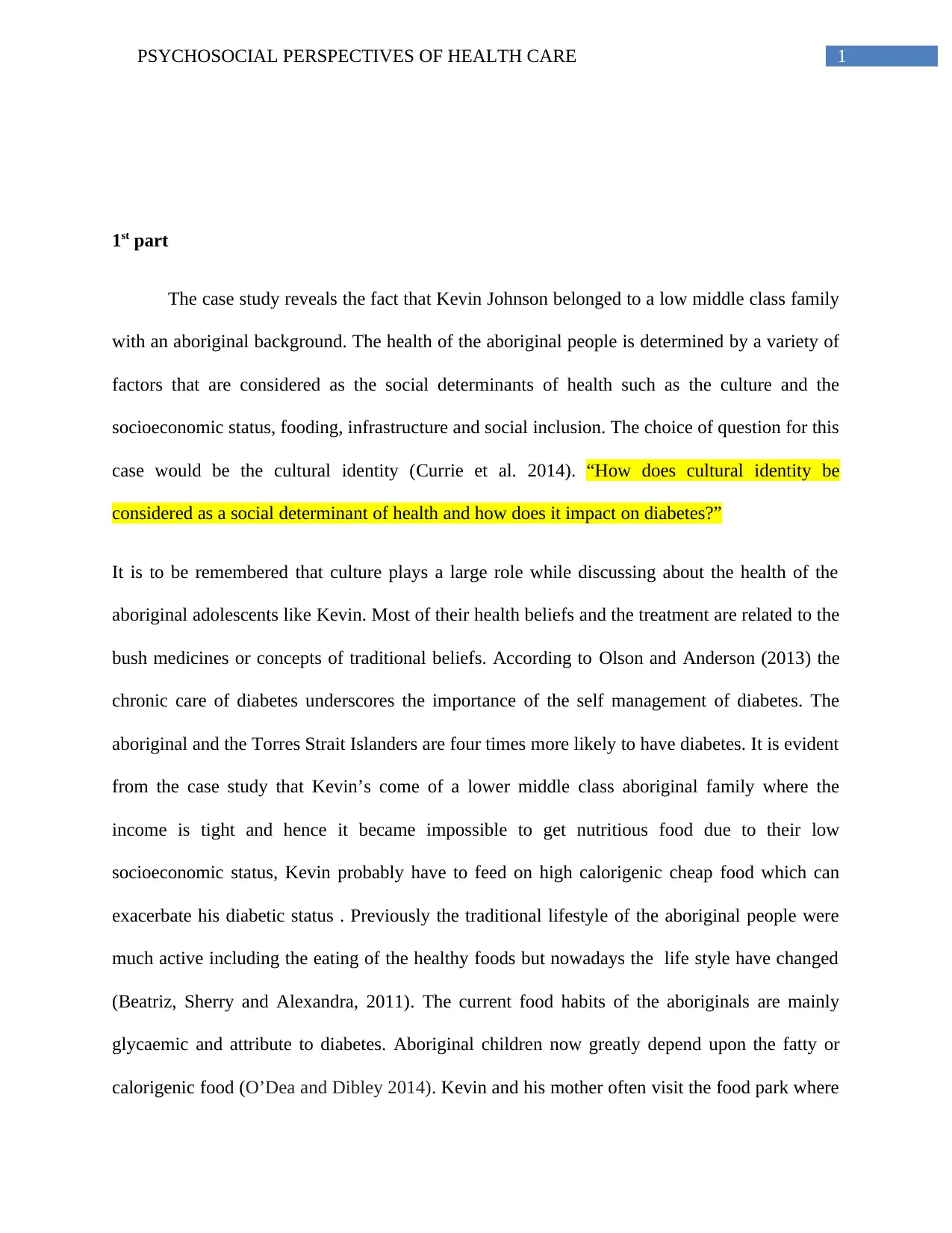
1PSYCHOSOCIAL PERSPECTIVES OF HEALTH CARE
1st part
The case study reveals the fact that Kevin Johnson belonged to a low middle class family
with an aboriginal background. The health of the aboriginal people is determined by a variety of
factors that are considered as the social determinants of health such as the culture and the
socioeconomic status, fooding, infrastructure and social inclusion. The choice of question for this
case would be the cultural identity (Currie et al. 2014). “How does cultural identity be
considered as a social determinant of health and how does it impact on diabetes?”
It is to be remembered that culture plays a large role while discussing about the health of the
aboriginal adolescents like Kevin. Most of their health beliefs and the treatment are related to the
bush medicines or concepts of traditional beliefs. According to Olson and Anderson (2013) the
chronic care of diabetes underscores the importance of the self management of diabetes. The
aboriginal and the Torres Strait Islanders are four times more likely to have diabetes. It is evident
from the case study that Kevin’s come of a lower middle class aboriginal family where the
income is tight and hence it became impossible to get nutritious food due to their low
socioeconomic status, Kevin probably have to feed on high calorigenic cheap food which can
exacerbate his diabetic status . Previously the traditional lifestyle of the aboriginal people were
much active including the eating of the healthy foods but nowadays the life style have changed
(Beatriz, Sherry and Alexandra, 2011). The current food habits of the aboriginals are mainly
glycaemic and attribute to diabetes. Aboriginal children now greatly depend upon the fatty or
calorigenic food (O’Dea and Dibley 2014). Kevin and his mother often visit the food park where
1st part
The case study reveals the fact that Kevin Johnson belonged to a low middle class family
with an aboriginal background. The health of the aboriginal people is determined by a variety of
factors that are considered as the social determinants of health such as the culture and the
socioeconomic status, fooding, infrastructure and social inclusion. The choice of question for this
case would be the cultural identity (Currie et al. 2014). “How does cultural identity be
considered as a social determinant of health and how does it impact on diabetes?”
It is to be remembered that culture plays a large role while discussing about the health of the
aboriginal adolescents like Kevin. Most of their health beliefs and the treatment are related to the
bush medicines or concepts of traditional beliefs. According to Olson and Anderson (2013) the
chronic care of diabetes underscores the importance of the self management of diabetes. The
aboriginal and the Torres Strait Islanders are four times more likely to have diabetes. It is evident
from the case study that Kevin’s come of a lower middle class aboriginal family where the
income is tight and hence it became impossible to get nutritious food due to their low
socioeconomic status, Kevin probably have to feed on high calorigenic cheap food which can
exacerbate his diabetic status . Previously the traditional lifestyle of the aboriginal people were
much active including the eating of the healthy foods but nowadays the life style have changed
(Beatriz, Sherry and Alexandra, 2011). The current food habits of the aboriginals are mainly
glycaemic and attribute to diabetes. Aboriginal children now greatly depend upon the fatty or
calorigenic food (O’Dea and Dibley 2014). Kevin and his mother often visit the food park where
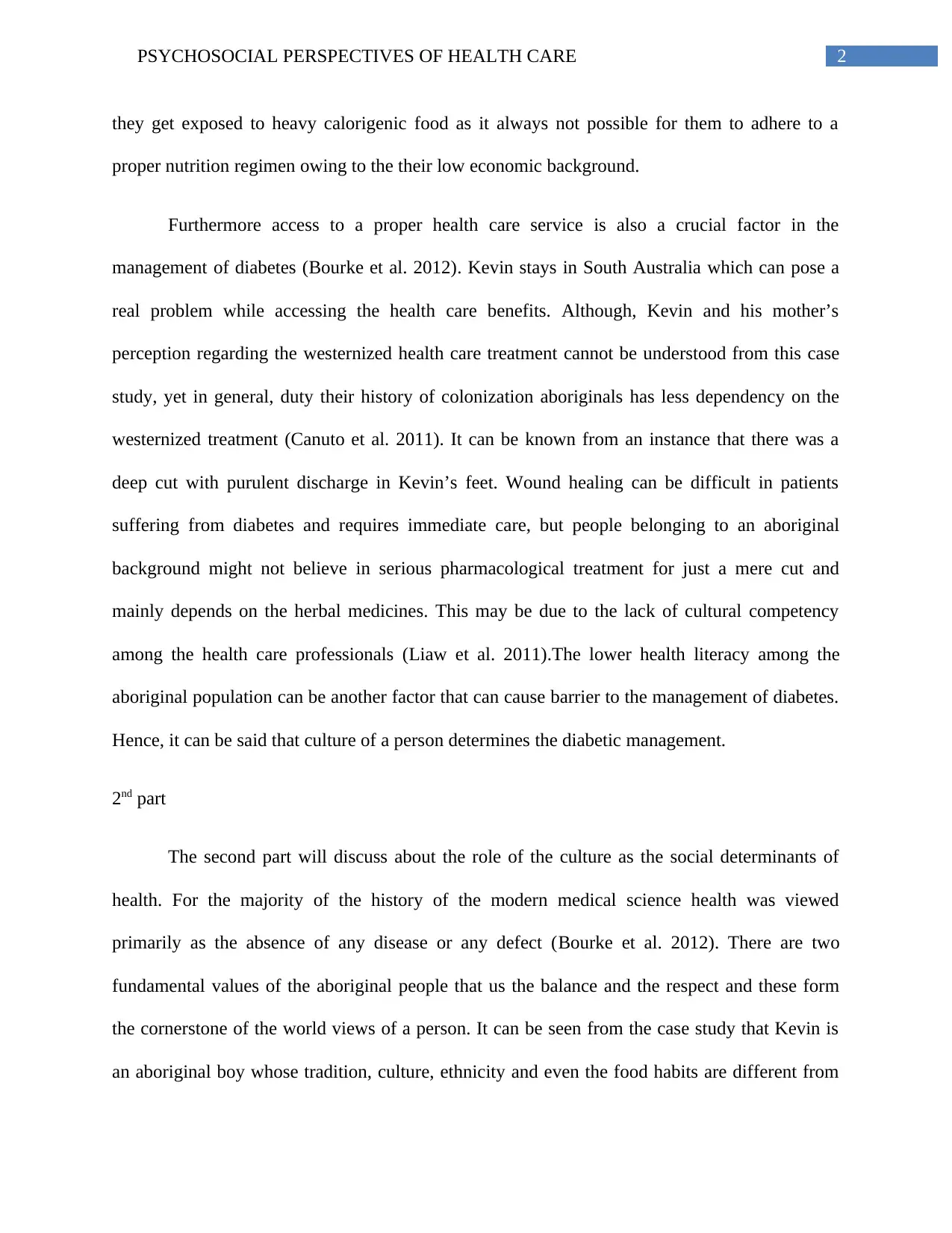
2PSYCHOSOCIAL PERSPECTIVES OF HEALTH CARE
they get exposed to heavy calorigenic food as it always not possible for them to adhere to a
proper nutrition regimen owing to the their low economic background.
Furthermore access to a proper health care service is also a crucial factor in the
management of diabetes (Bourke et al. 2012). Kevin stays in South Australia which can pose a
real problem while accessing the health care benefits. Although, Kevin and his mother’s
perception regarding the westernized health care treatment cannot be understood from this case
study, yet in general, duty their history of colonization aboriginals has less dependency on the
westernized treatment (Canuto et al. 2011). It can be known from an instance that there was a
deep cut with purulent discharge in Kevin’s feet. Wound healing can be difficult in patients
suffering from diabetes and requires immediate care, but people belonging to an aboriginal
background might not believe in serious pharmacological treatment for just a mere cut and
mainly depends on the herbal medicines. This may be due to the lack of cultural competency
among the health care professionals (Liaw et al. 2011).The lower health literacy among the
aboriginal population can be another factor that can cause barrier to the management of diabetes.
Hence, it can be said that culture of a person determines the diabetic management.
2nd part
The second part will discuss about the role of the culture as the social determinants of
health. For the majority of the history of the modern medical science health was viewed
primarily as the absence of any disease or any defect (Bourke et al. 2012). There are two
fundamental values of the aboriginal people that us the balance and the respect and these form
the cornerstone of the world views of a person. It can be seen from the case study that Kevin is
an aboriginal boy whose tradition, culture, ethnicity and even the food habits are different from
they get exposed to heavy calorigenic food as it always not possible for them to adhere to a
proper nutrition regimen owing to the their low economic background.
Furthermore access to a proper health care service is also a crucial factor in the
management of diabetes (Bourke et al. 2012). Kevin stays in South Australia which can pose a
real problem while accessing the health care benefits. Although, Kevin and his mother’s
perception regarding the westernized health care treatment cannot be understood from this case
study, yet in general, duty their history of colonization aboriginals has less dependency on the
westernized treatment (Canuto et al. 2011). It can be known from an instance that there was a
deep cut with purulent discharge in Kevin’s feet. Wound healing can be difficult in patients
suffering from diabetes and requires immediate care, but people belonging to an aboriginal
background might not believe in serious pharmacological treatment for just a mere cut and
mainly depends on the herbal medicines. This may be due to the lack of cultural competency
among the health care professionals (Liaw et al. 2011).The lower health literacy among the
aboriginal population can be another factor that can cause barrier to the management of diabetes.
Hence, it can be said that culture of a person determines the diabetic management.
2nd part
The second part will discuss about the role of the culture as the social determinants of
health. For the majority of the history of the modern medical science health was viewed
primarily as the absence of any disease or any defect (Bourke et al. 2012). There are two
fundamental values of the aboriginal people that us the balance and the respect and these form
the cornerstone of the world views of a person. It can be seen from the case study that Kevin is
an aboriginal boy whose tradition, culture, ethnicity and even the food habits are different from
⊘ This is a preview!⊘
Do you want full access?
Subscribe today to unlock all pages.

Trusted by 1+ million students worldwide
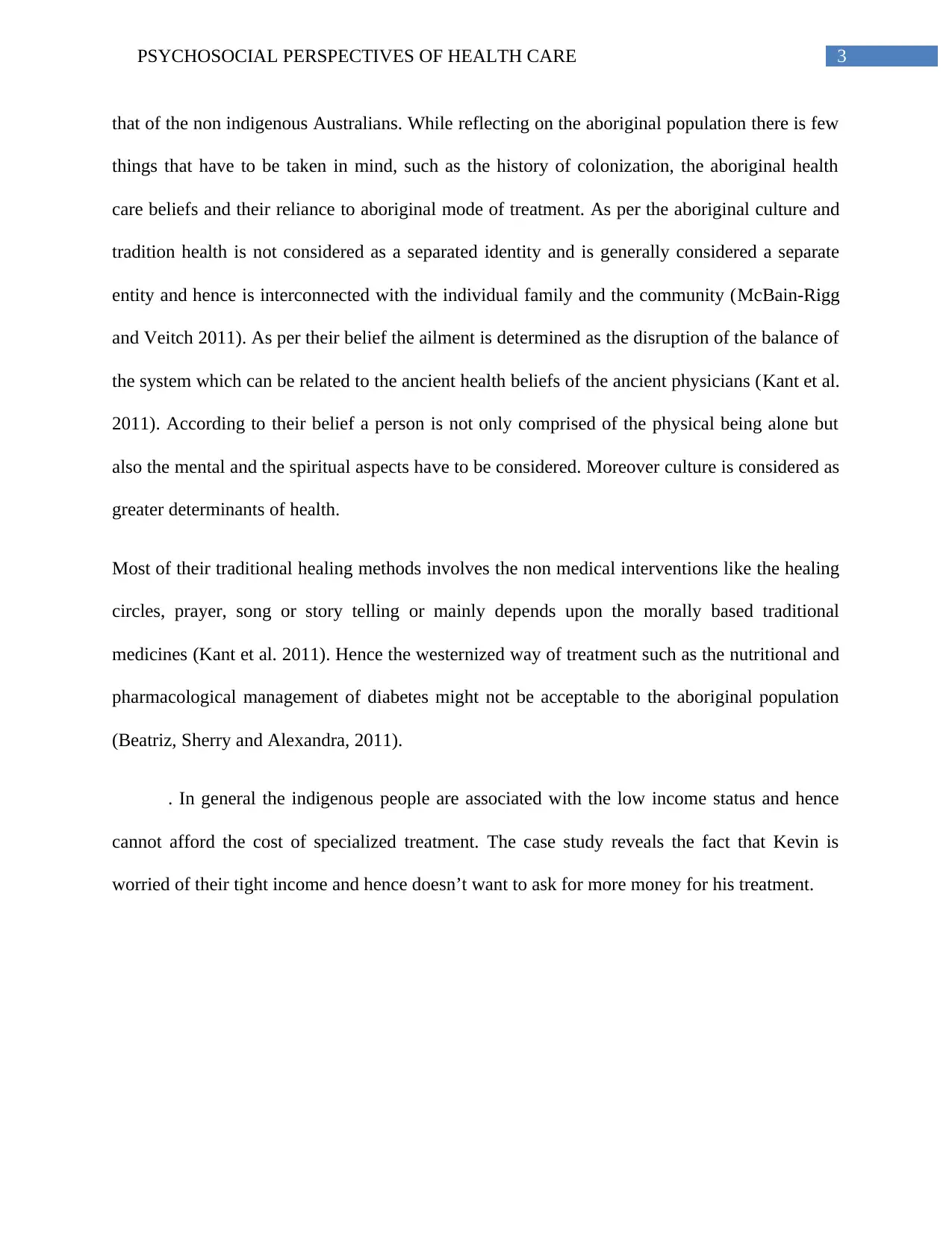
3PSYCHOSOCIAL PERSPECTIVES OF HEALTH CARE
that of the non indigenous Australians. While reflecting on the aboriginal population there is few
things that have to be taken in mind, such as the history of colonization, the aboriginal health
care beliefs and their reliance to aboriginal mode of treatment. As per the aboriginal culture and
tradition health is not considered as a separated identity and is generally considered a separate
entity and hence is interconnected with the individual family and the community (McBain‐Rigg
and Veitch 2011). As per their belief the ailment is determined as the disruption of the balance of
the system which can be related to the ancient health beliefs of the ancient physicians (Kant et al.
2011). According to their belief a person is not only comprised of the physical being alone but
also the mental and the spiritual aspects have to be considered. Moreover culture is considered as
greater determinants of health.
Most of their traditional healing methods involves the non medical interventions like the healing
circles, prayer, song or story telling or mainly depends upon the morally based traditional
medicines (Kant et al. 2011). Hence the westernized way of treatment such as the nutritional and
pharmacological management of diabetes might not be acceptable to the aboriginal population
(Beatriz, Sherry and Alexandra, 2011).
. In general the indigenous people are associated with the low income status and hence
cannot afford the cost of specialized treatment. The case study reveals the fact that Kevin is
worried of their tight income and hence doesn’t want to ask for more money for his treatment.
that of the non indigenous Australians. While reflecting on the aboriginal population there is few
things that have to be taken in mind, such as the history of colonization, the aboriginal health
care beliefs and their reliance to aboriginal mode of treatment. As per the aboriginal culture and
tradition health is not considered as a separated identity and is generally considered a separate
entity and hence is interconnected with the individual family and the community (McBain‐Rigg
and Veitch 2011). As per their belief the ailment is determined as the disruption of the balance of
the system which can be related to the ancient health beliefs of the ancient physicians (Kant et al.
2011). According to their belief a person is not only comprised of the physical being alone but
also the mental and the spiritual aspects have to be considered. Moreover culture is considered as
greater determinants of health.
Most of their traditional healing methods involves the non medical interventions like the healing
circles, prayer, song or story telling or mainly depends upon the morally based traditional
medicines (Kant et al. 2011). Hence the westernized way of treatment such as the nutritional and
pharmacological management of diabetes might not be acceptable to the aboriginal population
(Beatriz, Sherry and Alexandra, 2011).
. In general the indigenous people are associated with the low income status and hence
cannot afford the cost of specialized treatment. The case study reveals the fact that Kevin is
worried of their tight income and hence doesn’t want to ask for more money for his treatment.
Paraphrase This Document
Need a fresh take? Get an instant paraphrase of this document with our AI Paraphraser
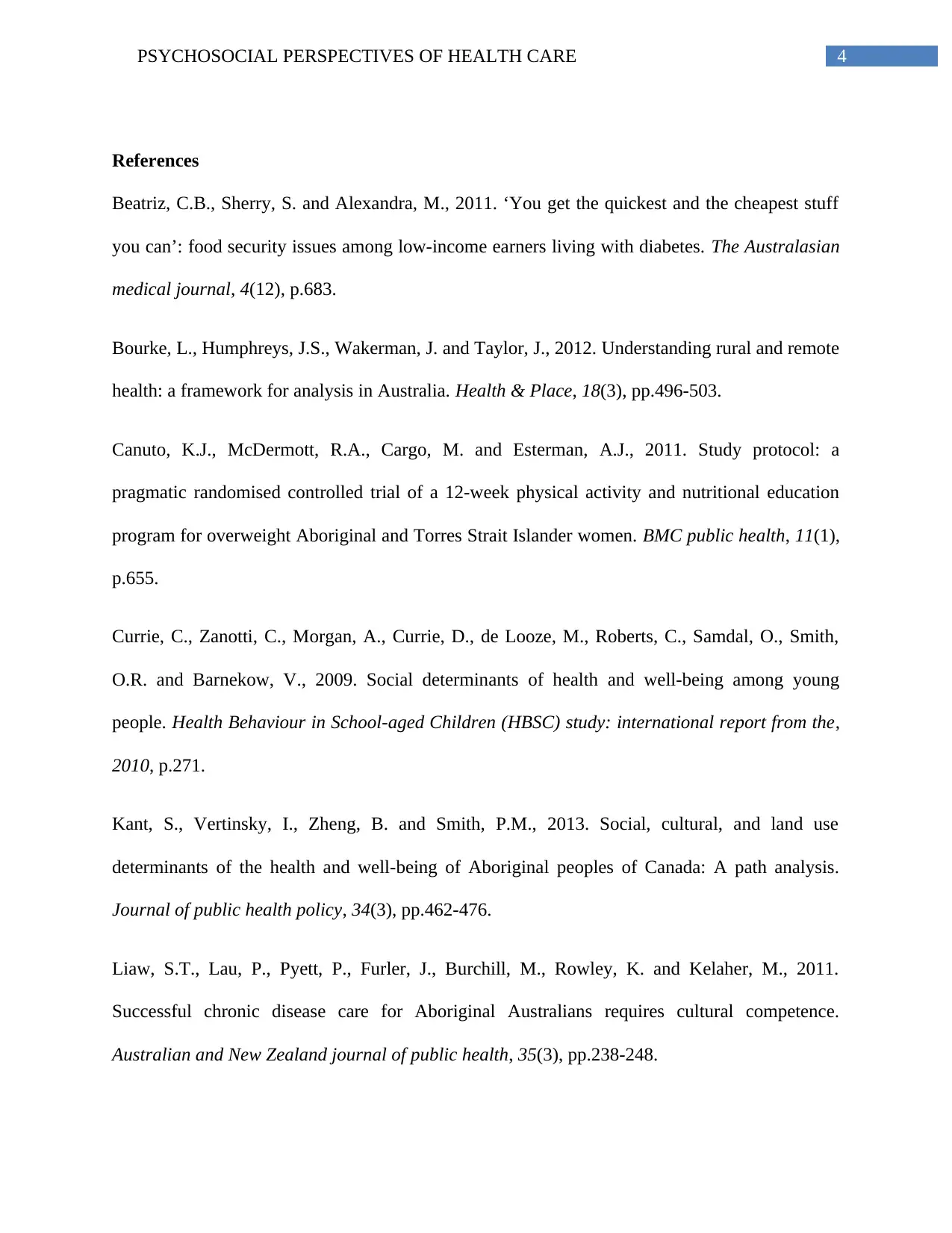
4PSYCHOSOCIAL PERSPECTIVES OF HEALTH CARE
References
Beatriz, C.B., Sherry, S. and Alexandra, M., 2011. ‘You get the quickest and the cheapest stuff
you can’: food security issues among low-income earners living with diabetes. The Australasian
medical journal, 4(12), p.683.
Bourke, L., Humphreys, J.S., Wakerman, J. and Taylor, J., 2012. Understanding rural and remote
health: a framework for analysis in Australia. Health & Place, 18(3), pp.496-503.
Canuto, K.J., McDermott, R.A., Cargo, M. and Esterman, A.J., 2011. Study protocol: a
pragmatic randomised controlled trial of a 12-week physical activity and nutritional education
program for overweight Aboriginal and Torres Strait Islander women. BMC public health, 11(1),
p.655.
Currie, C., Zanotti, C., Morgan, A., Currie, D., de Looze, M., Roberts, C., Samdal, O., Smith,
O.R. and Barnekow, V., 2009. Social determinants of health and well-being among young
people. Health Behaviour in School-aged Children (HBSC) study: international report from the,
2010, p.271.
Kant, S., Vertinsky, I., Zheng, B. and Smith, P.M., 2013. Social, cultural, and land use
determinants of the health and well-being of Aboriginal peoples of Canada: A path analysis.
Journal of public health policy, 34(3), pp.462-476.
Liaw, S.T., Lau, P., Pyett, P., Furler, J., Burchill, M., Rowley, K. and Kelaher, M., 2011.
Successful chronic disease care for Aboriginal Australians requires cultural competence.
Australian and New Zealand journal of public health, 35(3), pp.238-248.
References
Beatriz, C.B., Sherry, S. and Alexandra, M., 2011. ‘You get the quickest and the cheapest stuff
you can’: food security issues among low-income earners living with diabetes. The Australasian
medical journal, 4(12), p.683.
Bourke, L., Humphreys, J.S., Wakerman, J. and Taylor, J., 2012. Understanding rural and remote
health: a framework for analysis in Australia. Health & Place, 18(3), pp.496-503.
Canuto, K.J., McDermott, R.A., Cargo, M. and Esterman, A.J., 2011. Study protocol: a
pragmatic randomised controlled trial of a 12-week physical activity and nutritional education
program for overweight Aboriginal and Torres Strait Islander women. BMC public health, 11(1),
p.655.
Currie, C., Zanotti, C., Morgan, A., Currie, D., de Looze, M., Roberts, C., Samdal, O., Smith,
O.R. and Barnekow, V., 2009. Social determinants of health and well-being among young
people. Health Behaviour in School-aged Children (HBSC) study: international report from the,
2010, p.271.
Kant, S., Vertinsky, I., Zheng, B. and Smith, P.M., 2013. Social, cultural, and land use
determinants of the health and well-being of Aboriginal peoples of Canada: A path analysis.
Journal of public health policy, 34(3), pp.462-476.
Liaw, S.T., Lau, P., Pyett, P., Furler, J., Burchill, M., Rowley, K. and Kelaher, M., 2011.
Successful chronic disease care for Aboriginal Australians requires cultural competence.
Australian and New Zealand journal of public health, 35(3), pp.238-248.
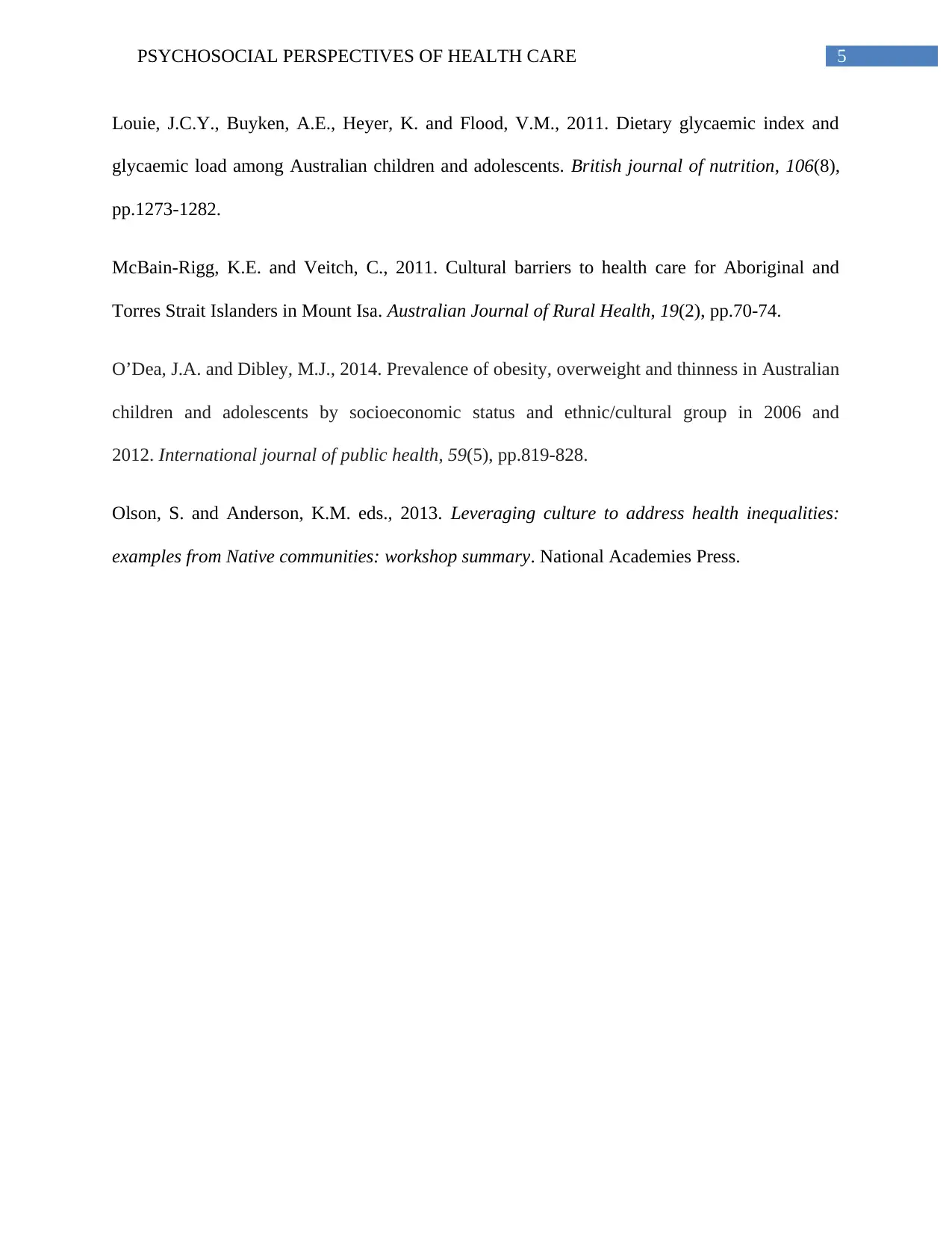
5PSYCHOSOCIAL PERSPECTIVES OF HEALTH CARE
Louie, J.C.Y., Buyken, A.E., Heyer, K. and Flood, V.M., 2011. Dietary glycaemic index and
glycaemic load among Australian children and adolescents. British journal of nutrition, 106(8),
pp.1273-1282.
McBain‐Rigg, K.E. and Veitch, C., 2011. Cultural barriers to health care for Aboriginal and
Torres Strait Islanders in Mount Isa. Australian Journal of Rural Health, 19(2), pp.70-74.
O’Dea, J.A. and Dibley, M.J., 2014. Prevalence of obesity, overweight and thinness in Australian
children and adolescents by socioeconomic status and ethnic/cultural group in 2006 and
2012. International journal of public health, 59(5), pp.819-828.
Olson, S. and Anderson, K.M. eds., 2013. Leveraging culture to address health inequalities:
examples from Native communities: workshop summary. National Academies Press.
Louie, J.C.Y., Buyken, A.E., Heyer, K. and Flood, V.M., 2011. Dietary glycaemic index and
glycaemic load among Australian children and adolescents. British journal of nutrition, 106(8),
pp.1273-1282.
McBain‐Rigg, K.E. and Veitch, C., 2011. Cultural barriers to health care for Aboriginal and
Torres Strait Islanders in Mount Isa. Australian Journal of Rural Health, 19(2), pp.70-74.
O’Dea, J.A. and Dibley, M.J., 2014. Prevalence of obesity, overweight and thinness in Australian
children and adolescents by socioeconomic status and ethnic/cultural group in 2006 and
2012. International journal of public health, 59(5), pp.819-828.
Olson, S. and Anderson, K.M. eds., 2013. Leveraging culture to address health inequalities:
examples from Native communities: workshop summary. National Academies Press.
⊘ This is a preview!⊘
Do you want full access?
Subscribe today to unlock all pages.

Trusted by 1+ million students worldwide
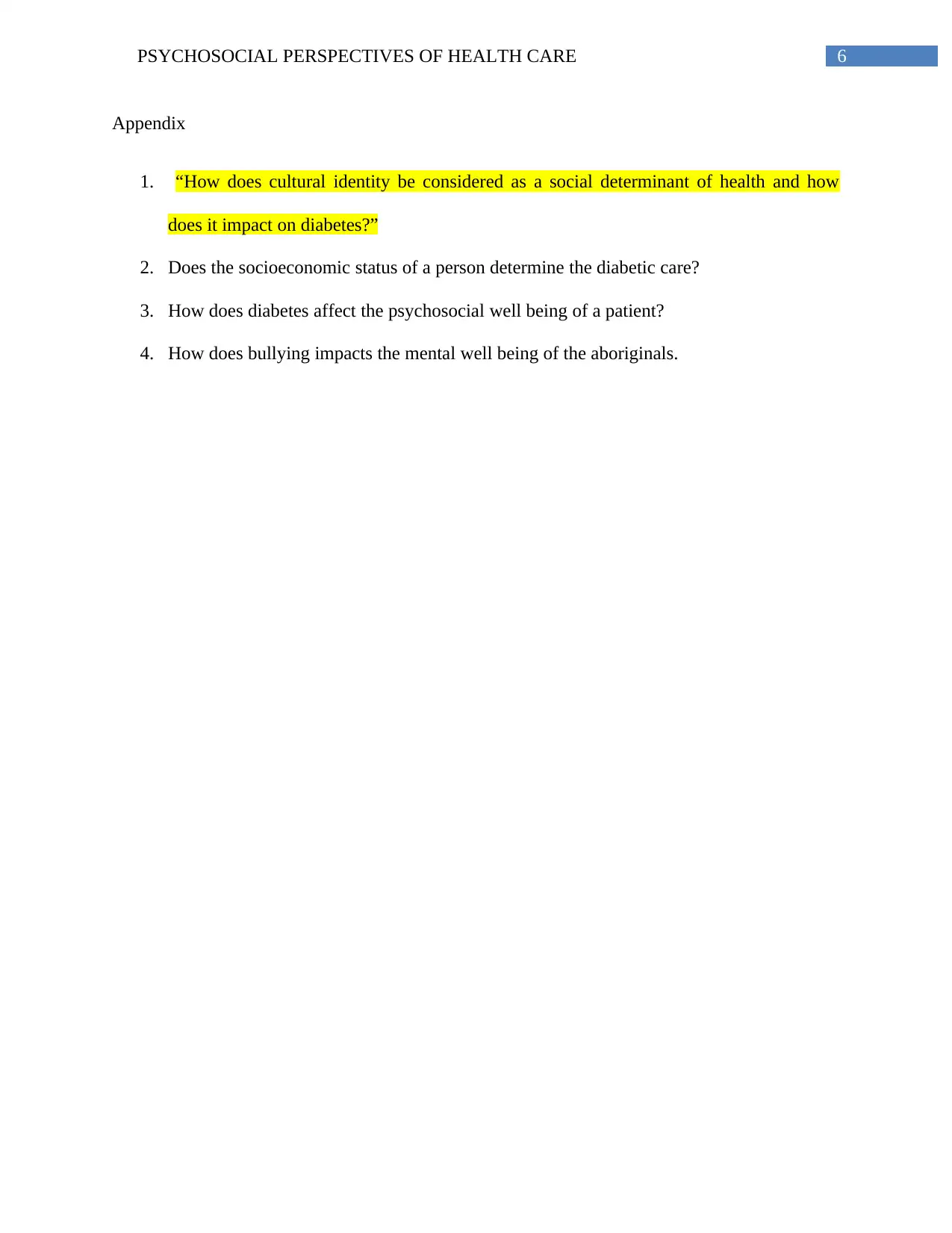
6PSYCHOSOCIAL PERSPECTIVES OF HEALTH CARE
Appendix
1. “How does cultural identity be considered as a social determinant of health and how
does it impact on diabetes?”
2. Does the socioeconomic status of a person determine the diabetic care?
3. How does diabetes affect the psychosocial well being of a patient?
4. How does bullying impacts the mental well being of the aboriginals.
Appendix
1. “How does cultural identity be considered as a social determinant of health and how
does it impact on diabetes?”
2. Does the socioeconomic status of a person determine the diabetic care?
3. How does diabetes affect the psychosocial well being of a patient?
4. How does bullying impacts the mental well being of the aboriginals.
1 out of 7
Related Documents
Your All-in-One AI-Powered Toolkit for Academic Success.
+13062052269
info@desklib.com
Available 24*7 on WhatsApp / Email
![[object Object]](/_next/static/media/star-bottom.7253800d.svg)
Unlock your academic potential
Copyright © 2020–2025 A2Z Services. All Rights Reserved. Developed and managed by ZUCOL.





